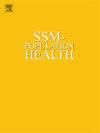To work or not to work? Child stunting and maternal labour force participation in South Africa
IF 3.1
2区 医学
Q1 PUBLIC, ENVIRONMENTAL & OCCUPATIONAL HEALTH
引用次数: 0
Abstract
Stunting, which affects about one-quarter of South African children below five years, has a long-term effect on a child's development and a potential economic cost to mothers. A stunted child necessitates more attention, thereby reducing the time a mother, especially if she is the primary caregiver, has available to seize labour market opportunities. This study investigated the relationship between child stunting and maternal labour force participation (MLFP) in South Africa, using a bivariate probit regression model. Data was sourced from the 2017 South African National Income Dynamics Study (NIDS). Using maternal height and improved water supply at home as instrumental variables to control for potential endogeneity, the average marginal effect model indicates that caring for a stunted child is associated with a 20 % reduction in MLFP, on average, at a 1 % statistical significance level. In addition to mothers' intrinsic merit of protecting their children, measures to prevent childhood stunting, such as nutrition education and promotion of exclusive breastfeeding, can improve MLFP. A more flexible working arrangement could facilitate mothers' engagement in the labour force while caring for their stunted children.
工作还是不工作?南非儿童发育迟缓和孕产妇劳动力参与情况
发育迟缓影响着大约四分之一的南非五岁以下儿童,它对儿童的发育有长期影响,并给母亲带来潜在的经济成本。发育迟缓的儿童需要更多的关注,从而减少了母亲抓住劳动力市场机会的时间,特别是如果她是主要照顾者的话。本研究使用双变量probit回归模型调查了南非儿童发育迟缓与母亲劳动力参与(MLFP)之间的关系。数据来自2017年南非国民收入动态研究(NIDS)。使用母亲身高和改善家庭供水作为工具变量来控制潜在的内生性,平均边际效应模型表明,照顾发育迟缓儿童与MLFP降低20%相关,平均而言,在1%的统计显著性水平上。除了母亲保护子女的内在价值外,预防儿童发育迟缓的措施,如营养教育和促进纯母乳喂养,也可以改善多胎生育率。更灵活的工作安排可以促进母亲在照顾发育迟缓的孩子的同时参与劳动力。
本文章由计算机程序翻译,如有差异,请以英文原文为准。
求助全文
约1分钟内获得全文
求助全文
来源期刊

Ssm-Population Health
PUBLIC, ENVIRONMENTAL & OCCUPATIONAL HEALTH-
CiteScore
6.50
自引率
2.10%
发文量
298
审稿时长
101 days
期刊介绍:
SSM - Population Health. The new online only, open access, peer reviewed journal in all areas relating Social Science research to population health. SSM - Population Health shares the same Editors-in Chief and general approach to manuscripts as its sister journal, Social Science & Medicine. The journal takes a broad approach to the field especially welcoming interdisciplinary papers from across the Social Sciences and allied areas. SSM - Population Health offers an alternative outlet for work which might not be considered, or is classed as ''out of scope'' elsewhere, and prioritizes fast peer review and publication to the benefit of authors and readers. The journal welcomes all types of paper from traditional primary research articles, replication studies, short communications, methodological studies, instrument validation, opinion pieces, literature reviews, etc. SSM - Population Health also offers the opportunity to publish special issues or sections to reflect current interest and research in topical or developing areas. The journal fully supports authors wanting to present their research in an innovative fashion though the use of multimedia formats.
 求助内容:
求助内容: 应助结果提醒方式:
应助结果提醒方式:


